Ever wished for a secret tool that could magically add a few more hours to your day? While that’s not quite possible, we’ve got the next best thing—time-tracking! It’s like having a secret map to uncover where your day sneaks off to. But it’s not just about tracking time; it’s about mastering it.

Welcome to a journey where we decode the enigma of time sheeting—the art of not just capturing minutes and hours but transforming them into a blueprint for efficiency. Throughout this guide, we’ll explore the manifold facets of time management, offering insights and techniques that transcend conventional approaches.
Whether you’re a pro in the field or dipping your toes into the vast sea of time management, this guide promises strategies and insights that will transform the way you perceive and utilize time. Get ready to decode the secrets, unearth the hacks, and revolutionize your relationship with time. Let’s embark on this voyage together and know about the 15 best time-tracking tips!
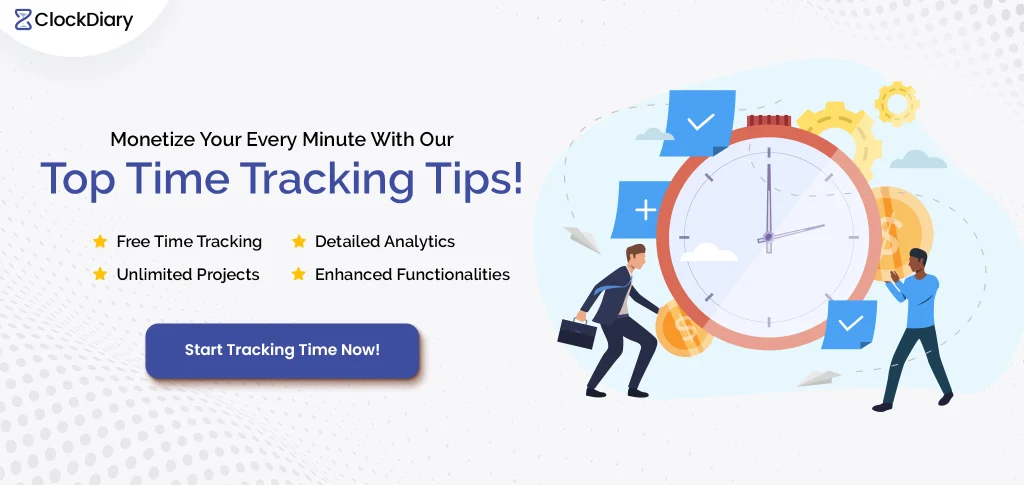
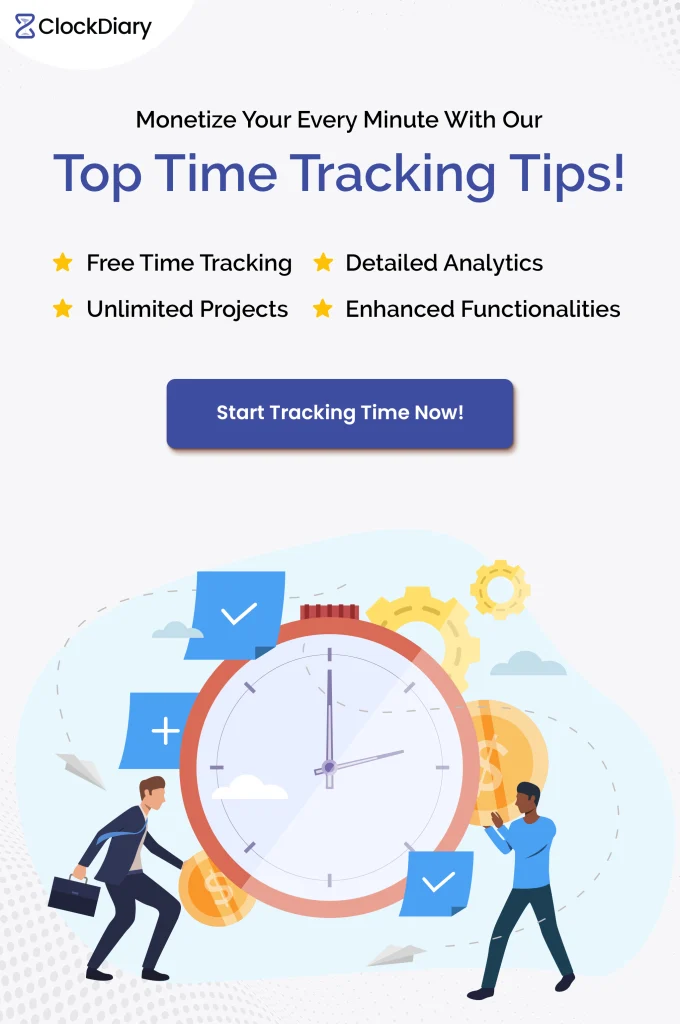
15 Best Time-Tracking Tips
Time is our most valuable asset, and managing it effectively can transform our productivity. Discover the top 15 time-tracking tips, proven to enhance efficiency, streamline workflows, and bring order to the chaos of your day.
1. Understanding Why It Is Important To Track Time
Embarking on the journey of time-tracking is more than a mere endeavor to clock in and out—it’s a strategic decision with profound implications for productivity, efficiency, and overall organizational success. It’s not just about knowing when you start and finish work; it’s about uncovering secrets about how you work, where your time goes, and how to make every minute count! So, before diving into it, it’s crucial to have a clear understanding of why it’s essential to track time, be it freelancers, individuals, businesses, or developers. Let’s understand tracking time better by asking some questions:
- How does tracking time unveil the hidden corners of your day, enabling proactive schedule management?
- Can tracking time be your managerial superpower, helping identify team members needing support due to workload variations?
- Could tracking time serve as your treasure map, directing you towards the most financially rewarding projects?
- What specialized vision does tracking time offer, revealing which clients boost profits and which require additional attention?
- How does tracking time eliminate guesswork, ensuring precise invoicing aligned with effort for client satisfaction and financial balance?
- Can tracking time act as your weapon against lost moments, uncovering where time slips away for more effective time management?
- How does tracking time unveil your most efficient moments, empowering strategic planning to enhance productivity?
2. Getting Your Team Onboard
One of the most important time-tracking tips is to get your team onboard. Getting your team onboard with time-tracking isn’t just about embracing a new tool; it’s about fostering a culture of efficiency, collaboration, and collective success. It’s about ensuring everyone feels empowered to navigate their workday more effectively.

Why It Matters:
- Team Spirit: Imagine having everyone rowing in sync towards the same productivity shore. Getting your team on board with time-tracking fosters a sense of unity and common goals.
- Clarity & Transparency: It’s like opening the curtains to the team’s workflow—employee time tracking brings clarity, showing who does what and when, fostering transparency among team members.
- Improved Collaboration: Time recording is the glue that strengthens teamwork. It encourages collaboration, making it easier to delegate tasks, coordinate efforts, and achieve collective success.
How to Achieve It:
- Lead by Example: Be the pioneer! Show your team the benefits of time-tracking by practising it yourself and sharing positive outcomes.
- Educate & Train: Make it a learning adventure. Offer clear explanations and training sessions to ensure everyone understands the purpose and benefits.
- Address Concerns: Listen to your team’s apprehensions and address them. Clear any doubts or misconceptions about time monitoring to create a supportive environment.
- Highlight Benefits: Show them the pot of gold! Emphasize how tracking time simplifies their workload, aids in better planning, and helps in personal productivity growth.
- Choose User-Friendly Tools: Opt for time tracking tools like ClockDiary that are user-friendly and adaptable to different working styles. Make the transition smoother for everyone.
3. Finding a Simple and User-Friendly Time Tracker
Discovering the right time tracking tool is like finding the perfect fit. A user-friendly interface streamlines the entire process, fostering seamless integration into your daily workflow. It’s crucial because it:
- Boosts Efficiency: Simplified time management saves valuable working hours, allowing you to focus more on productive tasks.
- Reduces Learning Curve: A user-friendly system minimizes the time spent on training, ensuring swift adoption across the team.
- Enhances Accuracy: Easy-to-use features mitigate errors in time entry, ensuring precise and reliable data for better decision-making.
ClockDiary – A Simple and User-Friendly Time Tracker For Your Daily Workflow

Choosing ClockDiary isn’t just about picking a time tracker; it’s about selecting a partner that aligns with your goals of efficiency, simplicity, and productivity. It’s about finding a tool that enhances your workflow without adding complexity.
- Automatic & Manual Time Tracking: ClockDiary gives you the power to track time your way—whether it’s hands-free automatic tracking or hands-on manual control.
- Project Details Management: Organize your projects hassle-free! Enter project specifics like descriptions, labels, and billing status effortlessly, ensuring your records stay well-structured.
- Comprehensive Reporting: You’re in command to access summarized or detailed reports with diverse filters. Explore, analyze, and export in formats that suit you best.
- Team Management: With ClockDiary, handling team activities becomes a breeze. Invite, assign roles, organize groups, and manage project details—all within your control.
- Customizable Options: Create custom fields, manage labels, and effortlessly tweak projects and customers. ClockDiary moulds to your evolving requirements effortlessly.
4. Automating Small Yet Crucial Details in Time-Tracking
In the world of time-tracking, automation is like having a trusty assistant managing the little things, allowing you to focus on the bigger picture. It’s about using clever shortcuts to simplify your workload and ensure precision without constant manual input.
Imagine having reminders that pop up when a deadline is nearing, keeping you on track effortlessly. Automation in time sheeting enables these gentle nudges, ensuring you never miss a crucial task’s deadline without having to watch the clock constantly.
Additionally, automation can swiftly categorize tasks or projects, sparing you the need to meticulously organize each entry. It’s the seamless sorting of your work, effortlessly assigning labels or categories as you log your time.
Moreover, consider the ease of automated billing. Setting up recurring billing cycles or automatically marking activities as billable or non-billable streamlines your financial records without the need for repetitive manual updates.
Finally, think about the convenience of scheduled reports. Automation allows you to set predefined filters and schedules, ensuring reports are generated at specific intervals. This saves valuable time that would otherwise be spent compiling data manually.
Automating these seemingly small yet pivotal aspects of time-tracking can significantly enhance your workflow, granting you more time to focus on your core tasks while maintaining accuracy and efficiency.
5. Saying Farewell to Spreadsheets in Time-Tracking
Leaving behind spreadsheets in time-tracking is a move towards a more efficient, error-free, and streamlined workflow. Shifting from manual spreadsheet-based tracking to dedicated time-tracking solutions brings several benefits:
- Time Savings: Automating tasks previously done manually on spreadsheets saves time on data entry and organization.
- Reduced Errors: Automation in time-tracking software minimizes human errors compared to manual input.
- Streamlined Workflows: Dedicated software simplifies tasks, easing categorization and analysis of time-related data.
- Enhanced Decision-Making: Accessible and accurate time data aids efficient resource allocation and project management decisions.
- Improved Collaboration: Real-time collaboration in time-tracking software fosters better teamwork and project coordination among team members.
Bidding adieu to spreadsheets in favour of dedicated time-tracking software like ClockDiary revolutionizes your approach to time management. It enhances accuracy, simplifies workflows, and ultimately boosts productivity and decision-making.
6. Use A Time Recorder As Well As Timesheets To Track Time
Efficient timekeeping forms the backbone of productive workflows. Utilizing a robust time recorder and timesheets goes beyond simple tracking—it’s about gaining insights, enabling informed decisions, and fostering organized teamwork. Let’s explore how leveraging these tools, especially within ClockDiary, offers a seamless and insightful approach to managing time-related activities within teams and projects.
Benefits of Time Recorder and Timesheets:
Time Recorder: A vital tool providing a detailed overview of time-related activities, aiding in project tracking, report generation, and data storage for informed decision-making.

Timesheets: Offering a holistic view of team members’ time entries, timesheets empower effective management and analysis of crucial time-related data.
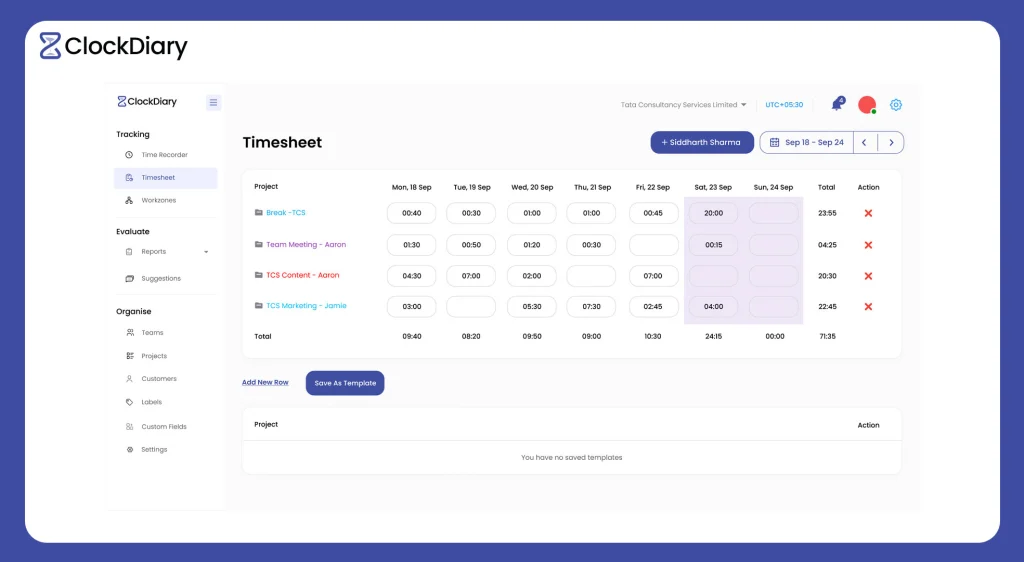
ClockDiary’s Features
Time Recorder: Within ClockDiary, managers can oversee and manage time-related activities within workzones, ensuring:
- Initiation of time tracker upon account creation or login.
- Recording of daily activities with project details and tags.
- Both manual and timer-based time trackers for enhanced flexibility.
- Organized time entries for effortless review and analysis.
Timesheets: ClockDiary’s timesheet features provide a consolidated view of team members’ time entries, enabling:
- Summaries of weekly time entries for specific team members.
- Intuitive navigation through different weeks via a user-friendly interface.
- Detailed project information and editable time entries for accuracy.
- Creation and storage of templates for efficient time management and evaluation.
By utilizing ClockDiary’s time recorder and timesheet features, teams can optimize time-tracking, streamline oversight, and make well-informed decisions, ultimately leading to enhanced productivity and efficient project management.
7. Tracking Billable and Non-Billable Activities
Let’s imagine a creative agency handling multiple client projects. While the time spent directly working on client deliverables (which is billable) is crucial, there’s also a substantial amount of time spent on non-client-related tasks.
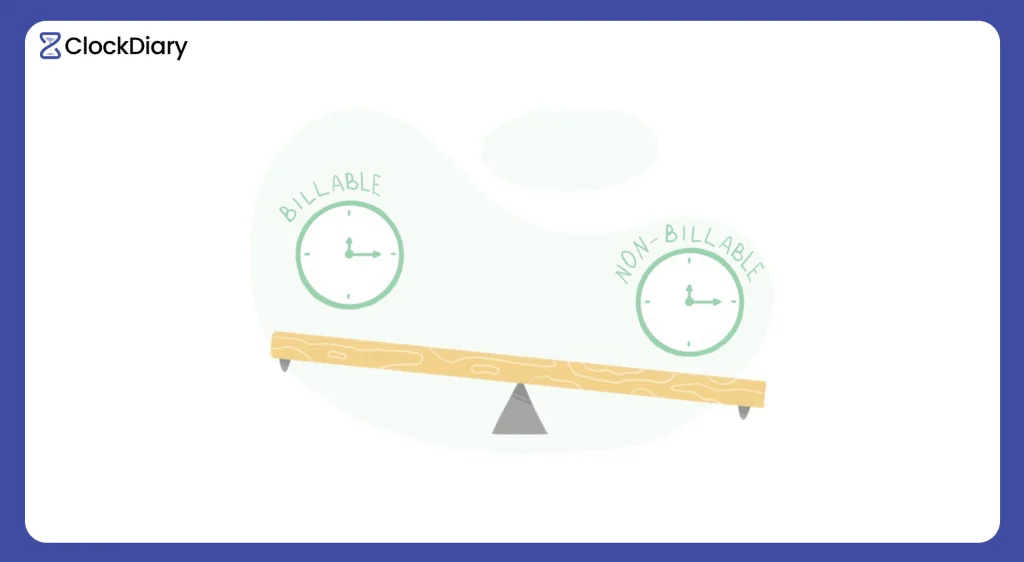
For instance, the team might spend time in internal meetings, brainstorming sessions, or conducting research to enhance their service offerings. These activities don’t directly generate revenue but are pivotal for the agency’s growth, service quality, and internal operations. Therefore, precisely monitoring both billable and non-billable activities is essential for effective time management.
Why It’s Essential
- Financial Accuracy: Tracking billable hours ensures precise invoicing, maintaining transparency and fairness in client billing.
- Resource Optimization: Monitoring non-billable tasks provides insights into resource allocation, aiding in better management of internal operations.
- Project Insight: Distinguishing billable and non-billable activities helps assess project profitability and resource utilization for better decision-making.
8. Organizing Time Around Projects

Imagine a consulting firm managing various projects for different clients. Each client project involves distinct tasks such as research, analysis, and client meetings. By organizing time around projects, the firm categorizes each project, creating a clear structure for tracking time. Here’s why it’s beneficial:
- Effective Categorization: Creating projects allows for meaningful categorization, whether by departments, clients, activities, or specific jobs. This categorization ensures a systematic grouping of related entries for easier analysis.
- Client-Centric Organization: Projects can be organized around clients, streamlining project management by associating various tasks and activities under each client. This categorization aids in better client-specific organization and reporting.
- Task Breakdown: Projects can be further subdivided into tasks, adding granularity to the hierarchy. Tasks indicate specific activities or sub-projects, offering a more detailed breakdown of time spent on different aspects of a project.
- Utilizing Tags for Precision: Tags or labels provide an additional layer of categorization independent of the project hierarchy. They offer more control and flexibility, allowing for the addition of specific information to time entries for easier filtering and identification.
9. Leveraging Extra Timer Features for Enhanced Productivity
Extra timer features are like productivity boosters. They help in maintaining focus, managing time efficiently, and staying on track with tasks. Some of the extra features that you can use in your day-to-day activities are idle detection, a pomodoro timer, and reminders. These features act as supportive tools to optimize your workflow.
- Idle Detection: This feature recognizes periods of inactivity. When you step away from your desk or take a break, the timer pauses automatically. It ensures precise time management by accounting only for active working hours.

- Pomodoro Timer: With the Pomodoro technique, you can break your work into intervals, typically 25 minutes of focused work followed by a short break. This method aids in maintaining concentration and prevents burnout by incorporating regular breaks into your workflow.
- Reminder Functionality: Setting reminders within the timer tool helps you stay on top of your tasks. You can schedule alerts for starting and stopping the timer at a particular time of the day. These reminders act as gentle nudges, ensuring you stick to your planned schedule.
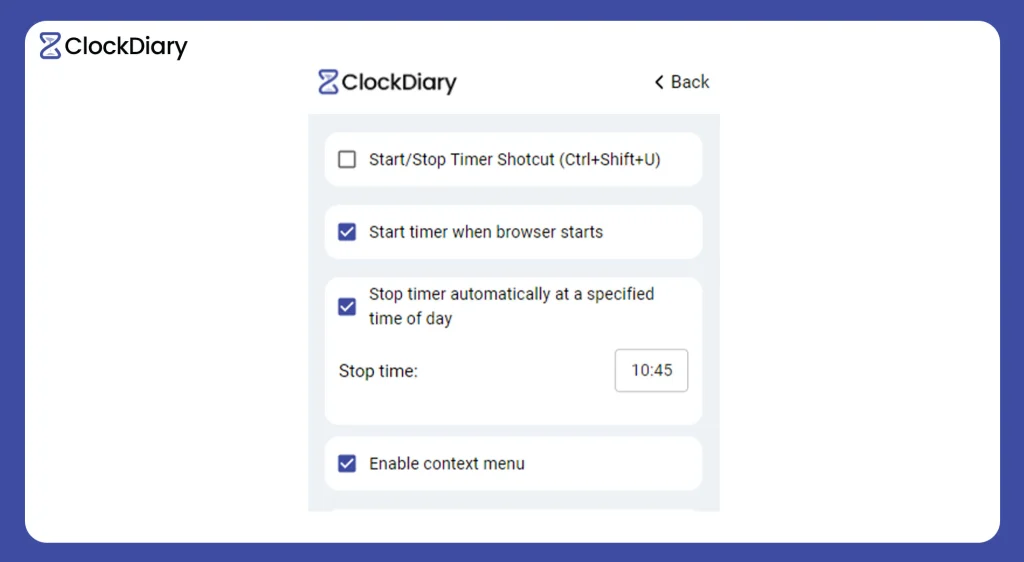
By leveraging these additional timer features, you can:
- Ensure accurate time-tracking by allowing idle detection to pause the timer during breaks.
- Employ the Pomodoro technique to break work into focused intervals, boosting concentration.
- Set reminders to prompt task changes or break times, maintaining a structured workflow.
10. Use Time-Tracking Data To Make Decisions
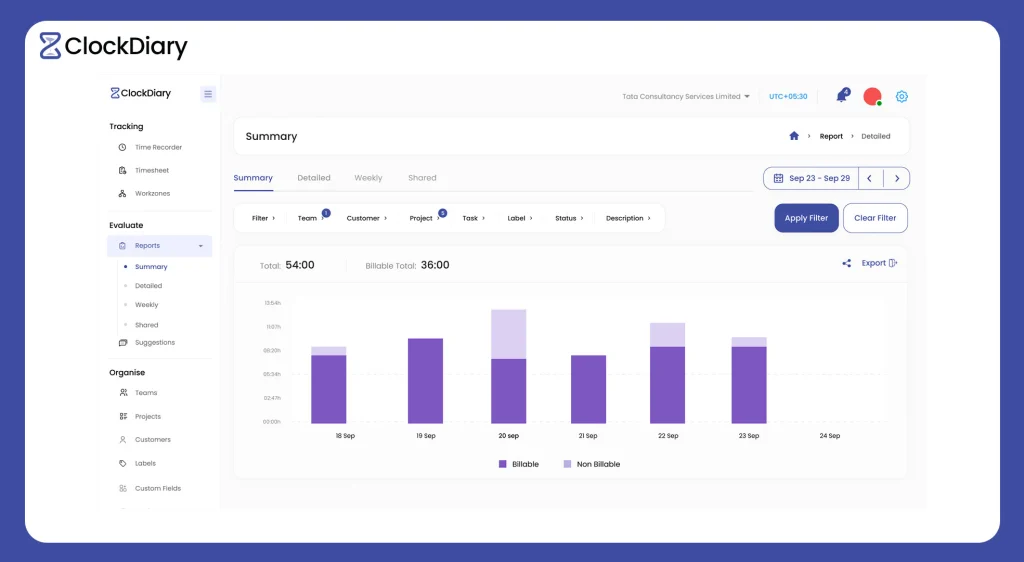
Time-tracking data is a catalyst for informed decisions, offering a comprehensive view of resource allocation, work patterns, and team performance. These insights drive strategic planning, optimize workflows, and fuel productivity gains. Leveraging this data empowers businesses to make precise, impactful decisions for operational excellence and sustained growth. Time-tracking data empowers decision-making:
- Strategic Insight: Analyze time across tasks, projects, or teams for efficient resource allocation and aligned priorities.
- Pattern Recognition: Unveil work habits, productivity trends, and peak performance periods to optimize workflows.
- Efficient Allocation: Accurate data aids in balanced resource distribution, identifying areas needing support.
- Performance Metrics: Evaluate individual/team productivity, fostering improvements for enhanced workflows.
Reports as a Data Source:
Within time-tracking tools like ClockDiary, reports serve as a reservoir of this valuable data:
- Summary Reports: These reports offer an analytical view through graphs and charts, providing a detailed examination of total hours, billable and non-billable hours expended over different periods.
- Sharing Functionality: Reports can be shared seamlessly with clients or team members, ensuring efficient collaboration while maintaining data security and privacy.
- Detailed Reports: These robust tools allow managers to comprehensively review tracked time, fine-tune entries, and allocate work hours effectively. They offer a detailed overview of tracked time across different time spans.
11. Keep Track Of Project Estimations Using Time-Tracking Data
Tracking project estimations with time-tracking data is a key strategy for precision in project management. It allows you to compare planned versus actual time spent on tasks. This data-driven approach provides invaluable insights, enabling you to refine future project estimations and set more accurate expectations for timelines and resource allocation. By aligning estimations with real-time data, businesses can enhance their planning processes and deliver projects more efficiently.
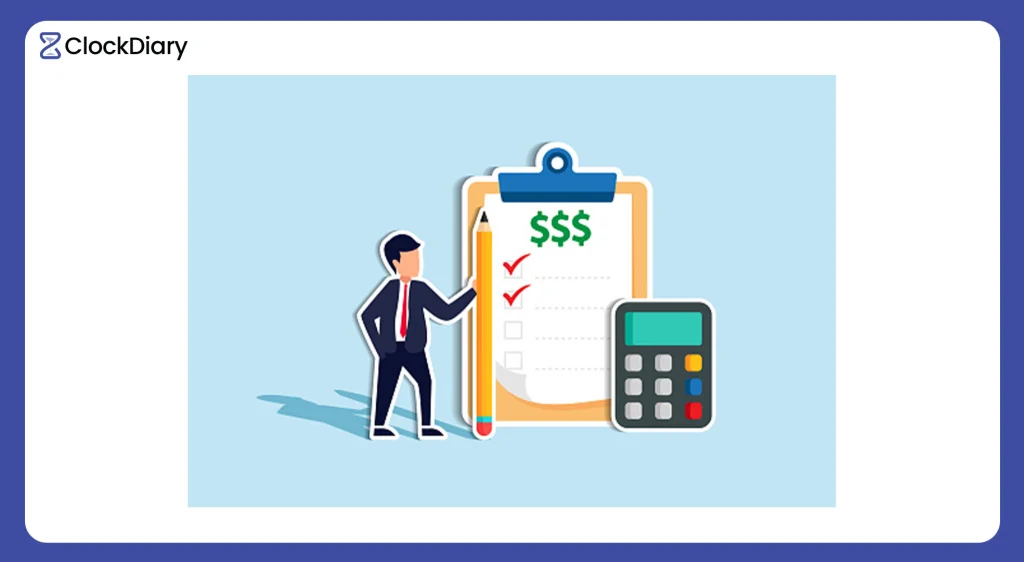
You can estimate project durations using time tracking tools in various ways:
- Analyzing Past Data: Reviewing similar tasks’ historical time data for patterns.
- Task Breakdown: Dividing projects into smaller tasks with time estimates.
- Real-Time Tracking: Recording actual time spent on each task.
- Comparison: Regularly comparing estimated versus actual time to refine future estimations.
12. Assign Someone To Review The Timesheets Daily
Ensuring precision in time-tracking records is pivotal. Assigning a dedicated individual to review timesheets daily enhances accuracy and resolves discrepancies promptly.
- Designated Oversight: Choose a team member or manager to oversee daily timesheet reviews in ClockDiary, fostering meticulousness in data.
- Automated Reminders: Leverage time tracking software’s automation features to set up reminders and notifications. These streamlined prompts ensure consistent and timely timesheet submissions.
- Reliable Checks: Configure reminders based on specific intervals or criteria to prompt team members, maintaining reliability and consistency in time-tracking records.
13. Making Time Tracking Data Transparent
Making time-tracking data transparent is crucial for fostering a culture of openness and accountability within teams. Transparent data provides insights into how time is utilized across projects, aiding in better resource allocation and project management. It also promotes trust among team members, as everyone has visibility into the collective effort and contributions, minimizing misunderstandings and conflicts.

This transparency encourages a collaborative environment where discussions around time tracking data become routine. Regular discussions based on this data facilitate problem-solving, process improvements, and better decision-making.
Individual access to their time-tracking information also empowers team members to self-assess, encouraging personal responsibility and improvement in time management practices. Overall, transparent time tracking data forms the foundation for informed decisions, clearer communication, and enhanced productivity within teams.
14. Lock Timesheets For Previous Weeks
Locking time tracks for previous weeks is essential to maintain accurate and reliable records within a time-tracking system. By implementing this practice, it ensures that the data captured for past durations remains unchanged and secure. This locking mechanism safeguards against accidental or unauthorized alterations to historical time entries, preserving the integrity of recorded hours and project details.

ClockDiary’s “Lock time” feature adds an additional layer of control:
- Flexible Duration: Managers can select the duration for which time entries should be locked, choosing from a set number of days or weeks.
- Preventing Modifications: Once time entries are locked, users cannot make any modifications or edits, ensuring data consistency and compliance.
15. Personalise Your Time-Tracking Data
Time-tracking doesn’t have to be a dull task! Adding a touch of personalization and fun elements can transform this process into an engaging and enjoyable experience. Consider these tips to personalize your time-tracking journey and infuse a bit of fun into the task.
- Custom Categories: Customize tracking by creating vivid categories for different tasks or projects, adding color and icons for better distinction.
- Reward System: Set achievable goals and celebrate milestones to encourage consistent tracking, offering small incentives for meeting targets.
- Visual Representation: Utilize charts or graphs for a visual breakdown of tracked time, making the data more accessible and engaging.
Conclusion
In the pursuit of productivity and effective time management, these 15 time tracking tips serve as guiding principles to help streamline tasks, enhance focus, and elevate efficiency. By implementing these strategies, individuals and teams can harness the power of time-tracking to optimize their schedules, identify productivity patterns, and make informed decisions. Remember, the goal isn’t just to track time but to leverage the insights gained to make tangible improvements in work habits and overall productivity.
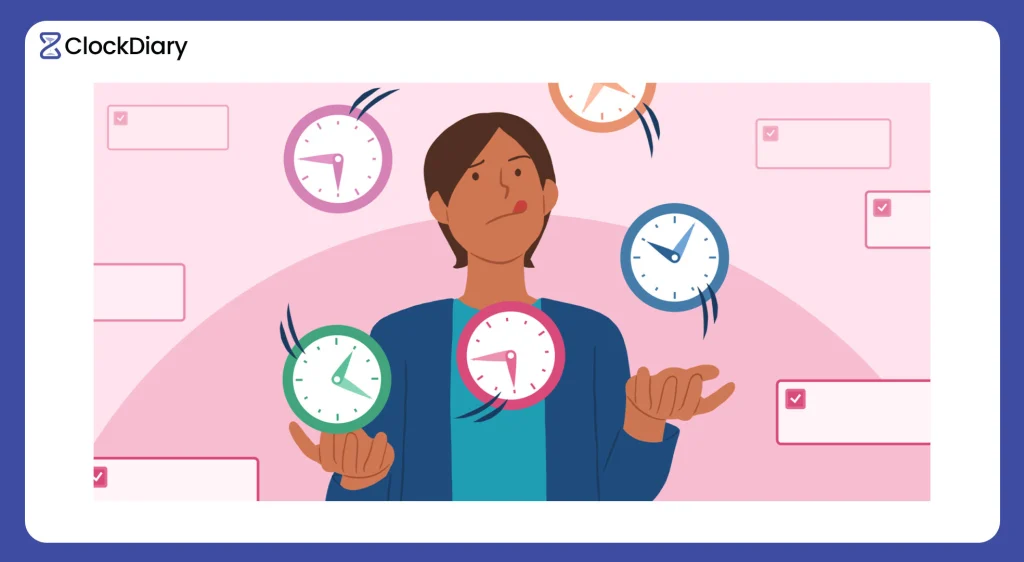
Amidst various time tracking tools available, ClockDiary emerges as a reliable ally in this journey. With its intuitive interface, robust features, and adaptability to diverse work styles, ClockDiary stands out as more than just a time tracking tool. It’s a comprehensive solution that enables seamless tracking, insightful reporting, and efficient project management. ClockDiary isn’t just about logging hours; it’s about empowering users to take charge of their time, boost productivity, and achieve a harmonious work-life balance.
So, why wait? Start your time-tracking journey and maximize your time efficiency today!
